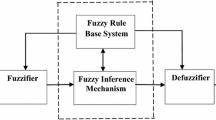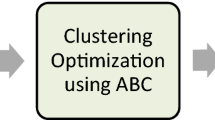Abstract
Congestion control in networks turns to be a crucial and challenging issue. This paper presents the cross layer mechanism for the management of congestion using Fuzzy based Cross layer mechanism using Oppostional Artificial Bee Colony (FCOABC) protocol. The proposed protocol integrates the notion of media accessibility and energy proficient hierarchical based cluster routing for increasing the network lifespan and energy efficiency. This proposed cross layer protocol uses fuzzy logic by means of considering the fuzzy descriptors such as, communication link reliability, number of neighboring nodes and precipitant (residual energy) for CH selection. Then, the network is organized into non-similar sized clusters (i.e. the clusters that are much closer to the MS holding smaller sizes and the clusters that are far away from the MS having larger sizes) for addressing the hot spots problem in WSN. The smaller sized cluster are considered because, the CHs of the smaller sized clusters are largely closer to the master station; thus, they experienced only small amount of intra-cluster congestion and forwards the relay traffic effectively using their preserved energy. Finally, the proposed FCOABC protocol employed the Oppositional Artificial Bee Colony optimization algorithm for performing inter cluster multi-hop routing from CHs to master station; therefore, an energy efficient and reliable data transfer is achieved to the master station. The operation of FCOABC protocol is primarily divided into three stages namely, Network-Association stage, nearest node detection stage and consistent-state stage. The results of conventional clustering protocols such as, ULCA, UCR, IFUC, and EAUCF is used for comparing the performance of proposed FCOABC protocol. The simulation results proved the efficiency of proposed FCOABC protocol on other clustering protocols in terms of the evaluation metrics such as, network lifespan, energy consumption, and scalability.













Similar content being viewed by others
References
Yick, J., Mukherjee, B., & Ghosal, D. (2008). Wireless sensor network survey. Journal on Computer networks,52(12), 2292–2330.
Gajjar, S. H., Pradhan, S. N., & Dasgupta, K. S. (2011). Wireless sensor network: Application led research perspective. In Recent advances in intelligent computational systems (RAICS) (pp. 025–030). IEEE.
Rault, T., Bouabdallah, A., & Challal, Y. (2007). Energy efficiency in wireless sensor networks: A top-down survey. Journal on Computer Networks,67, 104–122.
Wang, F., & Liu, J. (2011). Networked wireless sensor data collection: issues, challenges, and approaches. IEEE Communications Surveys & Tutorials,13(4), 673–687.
Gajjar, S., Choksi, N., Sarkar, M., & Dasgupta, K. (2014). Comparative analysis of wireless sensor network motes. In Signal processing and integrated networks (SPIN) (pp. 426–431). IEEE.
Chen, G., Li, C., Ye, M., & Jie, W. (2009). An unequal cluster-based routing protocol in wireless sensor networks. Journal on Wireless Networks,15(2), 193–207.
Zhao, X., & Wang, N. (2014). An unequal layered clustering approach for large scale wireless sensor networks. International Journal on Future Computer and Communication,1(2), 750–756.
Bagci, H., & Yazici, A. (2013). An energy aware fuzzy approach to unequal clustering in wireless sensor networks. Journal of Applied Soft Computing,13(4), 1741–1749.
Sundararaj, V. (2018). Optimal task assignment in mobile cloud computing by queue based Ant-Bee algorithm. Wireless Personal Communications. https://doi.org/10.1007/s11277-018-6014-9.
Sundararaj, V., Muthukumar, S., & Kumar, R. S. (2018). An optimal cluster formation based energy efficient dynamic scheduling hybrid MAC protocol for heavy traffic load in wireless sensor networks. Computers and Security, 77, 277–288.
Singh, R., & Verma, A. K. (2017). Energy efficient cross layer based adaptive threshold routing protocol for WSN. AEU - International Journal of Electronics and Communications, 72, 166–173.
Tambe, S., Kumar, V., & Bhusari, R. (2018). Magnetic induction based cluster optimization in non-conventional WSNs: A cross layer approach. AEU - International Journal of Electronics and Communications, 93, 53–62.
Singh, R., Rai, B. K., & Bose, S. K. (2017). A low delay cross-layer MAC protocol for k-covered event driven wireless sensor networks. IEEE Sensors Letters, 1(6), 1–4.
Ahmed, A. M., & Paulus, R. (2017). Congestion detection technique for multipath routing and load balancing in WSN. Wireless Networks, 23(3), 881–888.
Kalaikumar, K., & Baburaj, E. (2018). FABC-MACRD: Fuzzy and artificial Bee colony based implementation of MAC, clustering, routing and data delivery by cross-layer approach in WSN. Wireless Personal Communications. https://doi.org/10.1007/s11277-018-5872-5.
Tizhoosh, H. R. (2005). Opposition-based learning: A new scheme for machine intelligence. In Proceedings of international conference on computational intelligence for modelling, control and automation (pp. 695–701).
Sundararaj, V. (2016). An efficient threshold prediction scheme for wavelet based ECG signal noise reduction using variable step size firefly algorithm. International Journal of Intelligent Engineering and Systems, 9(3), 117–126.
Mao, S., Zhao, C., Zhou, Z., & Ye, Y. (2015). An improved fuzzy unequal clustering algorithm for wireless sensor network. Journal of Mobile Network Application,18(2), 206–214.
Kim, J., et al. (2008). CHEF: Cluster Head Election mechanism using Fuzzy logic in Wireless Sensor Networks. In International conference on advanced communication technology (pp. 654–659). IEEE.
Leonard, B., et al. (2011). Evaluation of an intelligent fuzzy based cluster head selection system using different parameters. In International conference on advanced information networking and applications (pp. 388–395). IEEE.
Hoda, T., et al. (2012). An energy aware distributed clustering protocol in Wireless Sensor Networks using fuzzy logic. Journal of Ad hoc Networks,10(7), 1469–1481.
Wei, D., et al. (2011). An energy efficient clustering solution for Wireless Sensor Networks. IEEE Transactions on Wireless Communications,10(11), 3973–3983.
Ebrahimnejad, A., Tavana, M., & Alrezaamiri, H. (2016). A novel artificial bee colony algorithm for shortest path problems with fuzzy arc weights. Measurement,93, 48–56.
Hashim, H. A., Ayinde, B. O., & Abido, M. A. (2014). Optimal placement of relay nodes in wireless sensor network using artificial bee colony algorithm. Journal of Network and Computer Applications,64, 239–248.
Karaboga, D., Gorkemli, B., Ozturk, C., & Karaboga, N. (2014). A comprehensive survey: Artificial bee colony (ABC) algorithm and applications. Journal of Artificial Intelligence,42(1), 21–57.
Heinzelman, W., Chandrakasan, A., & Balakrishnan, H. (2000). Energy-efficient communication protocol for wireless micro sensor networks. In Proceedings of the 33rd annual Hawaii international conference on system sciences (Vol. 2).
Tyagi, S., Gupta, S., Tanwar, S., & Kumar, N. (2013). Ehe-leach: enhanced heterogeneous leach protocol for life time enhancement of wirelesss ns. In 2013 international conference on advances in computing, communications and informatics (ICACCI) (pp. 1485–1490).
Jiang, C.-J., Shi, W. R., Xiang, M., & Tang, X. L. (2010). Energy-balanced unequal clustering protocol for wireless sensor networks. Journal of China Universities of Posts and Telecommunications,17(4), 94–99.
Wu, D., Bao, L., & Liu, C. H. (2013). Scalable channel allocation and access scheduling for wireless internet-of-things. IEEE Sensors Journal,13(10), 3596–3604.
Wu, D., Bao, L., Regan, A. C., & Talcott, C. L. (2013). Large-scale access scheduling in wireless mesh networks using social centrality. Journal of Parallel and Distributed Computing,73(8), 1049–1065.
Pahlavan, K., & Levesque, A. H. (2005). Wireless information networks. New York: Wiley.
Jang, J. S. R., Sun, C. T., & Mizutani, E. (2003). Neuro-fuzzy and soft computing: A computational approach to learning and machine intelligence. Upper Saddle River: Prentice Hall Publications.
Karaboga, D., & Akay, B. (2011). A modified Artificial Bee Colony (ABC) algorithm for constrained optimization problems. Applied Soft Computing,11, 3021–3031.
Marappan, P., & Rodrigues, P. (2016). An energy efficient routing protocol for correlated data using CL-LEACH in WSN. Journal of Wireless Networks,22(4), 1415–1423.
Sarwesh, P., Shet, N. S. V., & Chandrasekaran, K. (2018). ETRT–cross layer model for optimizing transmission range of nodes in low power wireless networks–an internet of things perspective. Physical Communication, 29, 307–318.
Heinzelman, W. B., Chandrakasan, A. P., & Balakrishnan, H. (2002). An application specific protocol architecture for wireless microsensor networks. IEEE Transactions on Wireless Communications,1(4), 660–670. https://doi.org/10.1109/TWC.2002.804190.
Rajagopalan, R., & Varshney, P. (2006). Data aggregation techniques in sensor networks: A survey. IEEE Communications and Surveys and Tutorials,8(4), 48–63. https://doi.org/10.1109/COMST.2006.283821.
The Network Simulator NS-2 Documentation. http://www.isi.edu/nsnam/ns/. Accessed October 18, 2015.
MathWorks Documentation Center. http://www.mathworks.in/help/matlab/. Accessed October 18, 2015.
Arboleda, L. M., & Nasser, N. (2006). Comparison of clustering algorithms and protocols for wireless sensor networks. In IEEE conference on electrical and computer engineering (pp. 1787–1792).
Author information
Authors and Affiliations
Corresponding author
Rights and permissions
About this article
Cite this article
Kalaikumar, K., Baburaj, E. Fuzzy enabled congestion control by cross layer protocol utilizing OABC in WSN: combining MAC, routing, non-similar clustering and efficient data delivery. Wireless Netw 26, 1085–1103 (2020). https://doi.org/10.1007/s11276-018-1848-3
Published:
Issue Date:
DOI: https://doi.org/10.1007/s11276-018-1848-3




